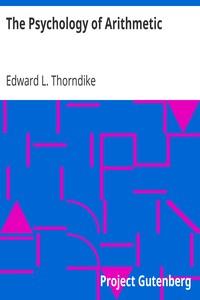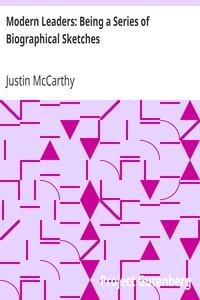|
|
Read this ebook for free! No credit card needed, absolutely nothing to pay.Words: 85034 in 27 pages
This is an ebook sharing website. You can read the uploaded ebooks for free here. No credit cards needed, nothing to pay. If you want to own a digital copy of the ebook, or want to read offline with your favorite ebook-reader, then you can choose to buy and download the ebook.

: The Psychology of Arithmetic by Thorndike Edward L Edward Lee - Arithmetic Study and teaching@FreeBooksWed 07 Jun, 2023 In this problem three different kinds of addends are combined, if we accept the usual distinction. Some may say that this is a mistake,--that the pupil transformed the 'whites,' 'free negroes,' and 'slaves' into a common unit, such as 'people' of 'population' and then added these common units. But this 'explanation' is entirely gratuitous, as one will find if he questions the pupil about the process. It will be found that the child simply added the figures as numbers only and then interpreted the result, according to the statement of the problem, without so much mental gymnastics. The writer has questioned hundreds of students in Normal School work on this point, and he believes that the ordinary mind-movement is correctly set forth here, no matter how well one may maintain as an academic proposition that this is not logical. Many classes in the Eastern Kentucky State Normal have been given this problem to solve, and they invariably get the same result:-- 'In a garden on the Summit are as many cabbage-heads as the total number of ladies and gentlemen in this class. How many cabbage-heads in the garden?' And the blackboard solution looks like this each time:-- So, also, one may say: I have 6 times as many sheep as you have cows. If you have 5 cows, how many sheep have I? Here we would multiply the number of cows, which is 5, by 6 and call the result 30, which must be linked with the idea of sheep because the conditions imposed by the problem demand it. The mind naturally in this work separates the pure number from its situation, as in algebra, handles it according to the laws governing arithmetical combinations, and labels the result as the statement of the problem demands. This is expressed in the following, which is tacitly accepted in algebra, and should be accepted equally in arithmetic: 'In all computations and operations in arithmetic, all numbers are essentially abstract and should be so treated. They are concrete only in the thought process that attends the operation and interprets the result.'" The following problems are taken at random from those given by one of the best of the textbooks that make the attempt to apply the facts of Greatest Common Divisor and Least Common Multiple to problems. Most of these problems are fantastic. The others are trivial, or are better solved by trial and adaptation. All this is so obvious that it may seem needless to relate. It is not. With many textbooks it is now necessary to give definite drill in reading the words in the printed problems intended for grades 2, 3, and 4, or to replace them by oral statements, or to leave the pupils in confusion concerning what the problems are that they are to solve. Many good teachers make a regular reading-lesson out of every page of problems before having them solved. There should be no such necessity. absentees account Adele admitted Agnes agreed Albany Allen allowed alternate Andrew Arkansas arrived assembly automobile baking powder balance barley beggar Bertie Bessie bin Boston bouquet bronze buckwheat Byron camphor Carl Carrie Cecil Charlotte charity Chicago cinnamon Clara clothespins collect comma committee concert confectioner cranberries crane currants dairyman Daniel David dealer debt delivered Denver department deposited dictation discharged discover discovery dish-water drug due Edgar Eddie Edwin election electric Ella Emily enrolled entertainment envelope Esther Ethel exceeds explanation expression generally gentlemen Gilbert Grace grading Graham grammar Harold hatchet Heralds hesitation Horace Mann impossible income indicated inmost inserts installments instantly insurance Iowa Jack Jennie Johnny Joseph journey Julia Katherine lettuce-plant library Lottie Lula margin Martha Matthew Maud meadow mentally mercury mineral Missouri molasses Morton movements muslin Nellie nieces Oakland observing obtained offered office onions opposite original package packet palm Patrick Paul payments peep Peter perch phaeton photograph piano pigeons Pilgrims preserving proprietor purchased Rachel Ralph rapidity rather readily receipts register remanded respectively Robert Roger Ruth rye Samuel San Francisco seldom sheared shingles skyrockets sloop solve speckled sponges sprout stack Stephen strap successfully suggested sunny supply Susan Susie's syllable talcum term test thermometer Thomas torpedoes trader transaction treasury tricycle tube two-seated united usually vacant various vase velocipede votes walnuts Walter Washington watched whistle woodland worsted If the reader doubts the need of this warning let him examine problems 1 to 5, all from reputable books that are in common use, or have been within a few years, and consider how addition, subtraction, and the habits belonging with each are confused by exercise 6. On one side of George's slate there are 32 words, and on the other side 26 words. If he erases 6 words from one side, and 8 from the other, how many words remain on his slate? A certain school has 14 rooms, and an average of 40 children in a room. If every one in the school should make 500 straight marks on each side of his slate, how many would be made in all? From the Declaration of Independence to the World's Fair in Chicago was 9 times as many years as there are stripes in the flag. How many years was it? Free books android app tbrJar TBR JAR Read Free books online gutenberg More posts by @FreeBooks
: Modern Leaders: Being a Series of Biographical Sketches by McCarthy Justin - Biography@FreeBooksWed 07 Jun, 2023

: The red cockade by Weyman Stanley John - Historical fiction; France History Revolution 1789-1799 Fiction@FreeBooksWed 07 Jun, 2023
|
Terms of Use Stock Market News! © gutenberg.org.in2025 All Rights reserved.






